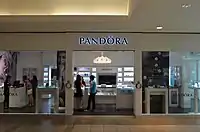 | |
 Corporate headquarters in Copenhagen, Denmark | |
| Type | Publicly traded Aktieselskab |
|---|---|
| ISIN | DK0060252690 |
| Industry | Jewellery Retail |
| Founded | 1982 |
| Founder | Per Enevoldsen |
| Headquarters | Havneholmen 17 - 19 DK-1561 Copenhagen , Denmark |
Number of locations | 7,092 (2020) |
Area served | Worldwide |
Key people | |
| Revenue | |
| Total assets | |
| Total equity | |
Number of employees | 26,000 (2020) |
| Website |
|
| Footnotes / references Financial Reporting | |
Pandora A/S (often styled PANDORA) is a Danish jewellery manufacturer and retailer founded in 1982 by Per Enevoldsen.[3] The company started as a family-run jewellery shop in Copenhagen.
Pandora is known for its customizable charm bracelets, designer rings, earrings, necklaces and (now discontinued) watches. The company has two production sites in Thailand and markets its products in more than 100 countries on six continents with more than 6,700 points of sale.
History
Pandora was founded in 1982 by Danish goldsmith Per Enevoldsen and, his then-wife, Winnie Enevoldsen.[4] The pair began on a small scale by importing jewellery from Thailand and selling to consumers.[5]
In 1987, the company ended its retail operations and became a pure wholesaler; two years later Enevoldsen hired in-house designers and established a manufacturing site in Thailand, where it is still located. With low production costs and an efficient supply chain, the Enevoldsens could provide affordable, hand-finished jewellery for the mass market. Pandora's collection grew to include an assortment of rings, necklaces, earrings and watches. It started selling its signature charm bracelets in 2000 after several years of development, protected by a patent.[6]
The Danish private equity group Axcel bought a 60% stake in the company from the Enevoldsen family in 2008. Shares totalling DKK 9.96 billion (US$ 1.84 billion) were sold in an IPO in October 2010, one of the biggest IPOs in Europe that year, giving Pandora a market capitalisation of around DKK 27 billion.[7] The company is publicly listed on the NASDAQ OMX Copenhagen Stock Exchange in Denmark and is a component of the OMX Copenhagen 20 index.
Pandora became the world's third-largest jewellery company in terms of sales, after Cartier and Tiffany & Co.[5] In 2011, more than one piece of Pandora jewellery was sold every second on average.[8]
Shares fell nearly 80% in 2011 after a shift in focus to higher-end designs alienated core customers, but performance recovered after a return to the more affordable mass market, with the group reporting revenue of DKK 19 billion and net profit in excess of DKK 3 billion in 2014.[9] In 2020 and due to the Covid-19 pandemic, 80% of Pandora's 2,700 stores around the world were closed. However, the company kept paying to all its staff in full, even for those who used to work in the closed stores.[10]
In early May 2021, Pandora announced the company would phase out mined diamonds in favour of gems manufactured in a laboratory. The new diamond jewellery was first sold in the United Kingdom before being sold globally in 2022.[11]
Pandora is one of the world's largest jewellery brands with 19 billion Danish kroner in revenue and a retail network of around 2,700 stores.
Distribution network
Sales of the Pandora brand began in Europe and it first entered North America in 2003. The company opened concept stores around the world before its franchising model began in Australia in 2009.[8] Pandora products are sold in more than 100 countries on six continents through approximately 6,700 points of sale, including approximately 2,400 concept stores.[12] The company employs over 26,000 people, of whom 13,200 are located in Thailand, the company's sole manufacturing site since 1989.[13]
Pandora launched an online sales platform in Europe in 2011, and began working to expand its e-commerce to the majority of its markets including Australia.[14]
Europe and the United States accounted for nearly 90% of group sales in 2014. The group announced a Chinese distribution deal in 2015, with plans to increase store numbers to "a couple of hundred" in China.[9] In 2015, it bought out Oracle Investment's shares in its Chinese distribution service.[15]
 Toronto, Fairview Mall Branch
Toronto, Fairview Mall Branch
References
- ↑ "OMX Copenhagen 25 (OMXC25CAP)".
- ↑ "OMX Copenhagen 25 (OMXC25CAP)" (PDF). Nasdaq OMX. Archived from the original (PDF) on 13 March 2022.
- ↑ "Birth of brand Pandora". 16 August 2009.
- ↑ "The Pandora story".
- 1 2 Rachlin, Natalia (6 December 2011). "A Danish Fairy Tale Gone Awry". New York Times.
- ↑ Lieber, Chavie (23 August 2016). "The Charmed Life of Pandora". Racked. Vox Media. Retrieved 24 August 2016.
- ↑ Arnold, Martin (5 October 2010). "Pandora shares leap on Copenhagen debut". Financial Times.
- 1 2 Bitti, Mary Teresa (22 January 2014). "How Pandora Jewellery grew to become a mega global brand". Financial Post.
- 1 2 Barrett, Claer; Paton, Elizabeth (17 February 2015). "Pandora's jewellery earnings charm the market". Financial Times.
- ↑ "Pandora paying all staff in full through pandemic". BBC News. 2020-11-08. Retrieved 2020-11-10.
- ↑ Mellor, Sophie (2021-05-04). "World's biggest jewelry giant shifts to lab-produced diamonds as millennials shun mined gems". Fortune. Retrieved 2021-05-05.
- ↑ "PANDORA | About PANDORA - Jewellery Brand Values and History". PANDORA. Retrieved 2016-11-16.
- ↑ Pandora A/S (9 September 2014). "PANDORA A/S NOTICE OF EXTRAORDINARY GENERAL MEETING". GlobeNewswire News Room.
- ↑ Katarina Gustafsson (11 November 2014). "Pandora Seeks to Tap 'Hopeless' Male Shoppers With Web Expansion". Bloomberg.
- ↑ "PANDORA ENTERS INTO STRATEGIC ALLIANCE IN CHINA", 17 February 2015. Nasdaq Globe Newswire. Accessed 19 February 2016.